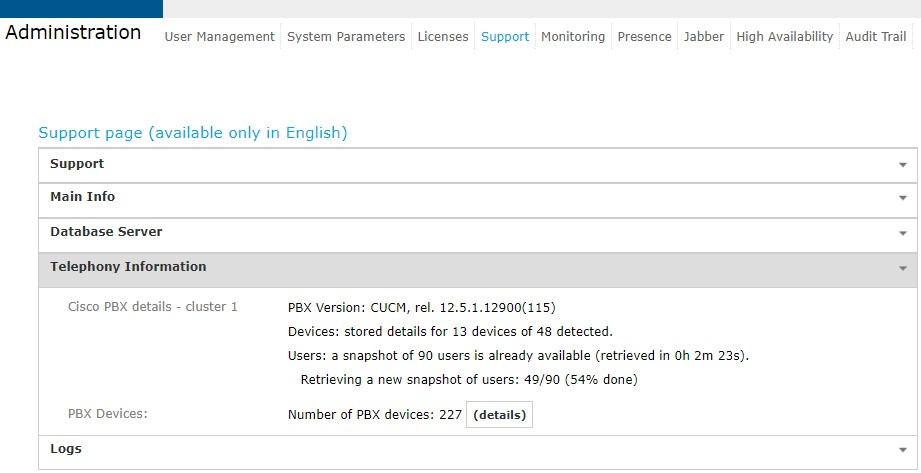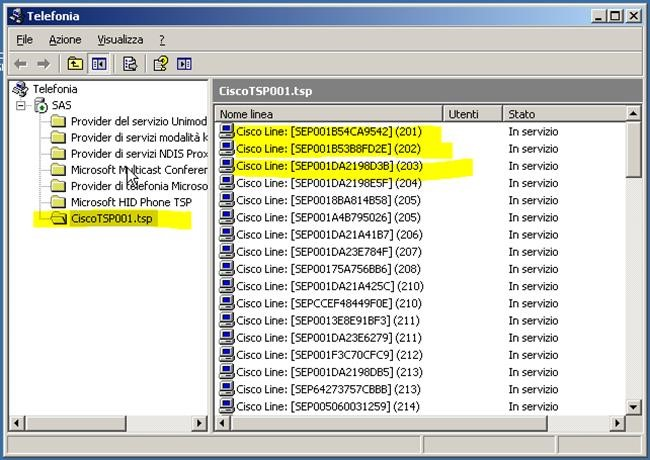UCX Suite Troubleshooting in a Cisco UCM environment
Following check controls are needed to verify correct interaction between UCX Suite and Cisco UCM cluster.
For each check control, Imagicle suggests a basic troubleshooting to unveil most common problems.
AXL Devices Download from CUCM
Imagicle server periodically downloads the list of all phone devices from a CUCM node (typically, the Publisher), using AXL-HTTPS protocol on TCP port 8443. This feature is very important, because in this way the UCX Suite knows what phone devices are currently registered to CUCM and their relevant user’s association.
In order to check proper device synchronization, please access to UCX Suite web portal and select following menu item: ADMIN ⇒ Support
Please check “Telephony Information” and verify that CUCM current version is correctly displayed, as in below screenshot sample:

Note: If no CUCM version appears, please verify below items:
CUCM’s Publisher IP address and relevant “ImagicleCTI” credentials are correctly set into: ADMIN ⇒ System Parameters ⇒ IP Telephony system parameters;
Please verify that Cisco AXL service is active on CUCM cluster node in use. Otherwise, please select another cluster node in System Parameters.
Check that the "ImagicleCTI" Application User in CUCM includes "Standard AXL API Access" role.
Check CUCM reachability through the following web URL: https://[CUCM_IP_address]:8443/axl
If all above options are correct, please restart Imagicle AXL Client service, from Windows’ Services control panel (RDP access).
CTI/TAPI monitoring of Cisco phone devices
Background information
TAPI (Telephony Application Program Interface) is used by Imagicle Advanced Queuing application to monitor real-time telephony status of operators/agents configured into waiting queues. A proper TAPI monitoring allows an efficient call routing using "priority" and "idle time" algorithms. Moreover, TAPI is used to control the phone device associated to operator's Imagicle Attendant Console, plus real-time BLF status of Colleagues. Phone lock application might leverage TAPI engine to trigger line lock/unlock based on phone devices. Finally, Call Recording leverages TAPI to allow on-demand recording start/stop from relevant Imagicle phone service and Jabber gadget.
Verify TAPI enablement
Please access to Imagicle UCX Suite server from RDP/VMware console and run the following application: TAPIMGMT.MSC
A window appears, including a list of Tapi providers. Pls. click on “CiscoTSP001.tsp” and verify that the list of monitored Cisco phones appears in the right panel, including relevant extension numbers. Same list should include CTI Park ports, needed for attendant console.
See screenshot sample below:

Note: If providers list does not include CiscoTSP001.tsp, it means that 64-bit Cisco TAPI client installation went wrong or server reboot hasn’t been accomplished. Pls. repeat installation procedure.
If CiscoTSP001.tsp provider appears, but the right-hand panel is empty, please verify below items:
CUCM nodes IPs and credentials (ImagicleCTI/ImagicleCTI) have been correctly entered. Please right-click on CiscoTSP001.tsp provider and select “Configure” from pull-down menu;
Please verify that CallManager nodes are pingable from IAS server.
Pls. make sure that TAPI client you installed is consistent with Cisco UCM version.
Please remember that, for a redundant solution, Cisco TSP client must be installed on both primary/backup Imagicle servers, entering local CUCM node IP if DR is in place.
Presence Subscription (Cisco Unified Presence Server)
To double check correct presence acquisition, please access to Imagicle web portal and select the following menu item: ADMIN ⇒ Presence ⇒ Diagnostic
Verify that “Successfully connected” green alert is shown.
Note: In some case, you can get an alert related to invalid credentials. This might happen if “ImagicleCTI” user is not configured in CUPS. This is not preventing presence acquisition.

If you get an “Error during connection” alert instead, this means UCX Suite can’t communicate with CUPS.

In this case, please check:
CUPS server is reachable by Imagicle server (use ping).
No firewall rules blocking UDP traffic on port 5060.
CUPS has been configured to allow presence queries from Imagicle server(s). See here.
Domain name is correctly set and it matches CUPS domain.
Once done, please perform a stop/start of both presence services. This option is available in “Manage Services” tab.
Web/XML services access through DNS (HA Solution)
If DNS configuration has been applied, it is possible to verify its correct functionality by following below action items:
Open a web browser from any user’s PC and type URL including UCX Suite server’s virtual host name. For example: http://imagicle.mycompanydomain.com; Imagicle web portal login page shall appear.
Select an Imagicle XML service from any Cisco IP Phone and verify you can navigate into different menu options.
Turn off primary IAS server or disconnect it from network. Wait for a couple of minutes.
Exit web browser and repeat step #1. Web portal login page should appear.
Repeat step #2, too, by selecting a XML phone service on IP Phone.
